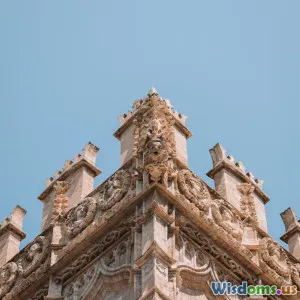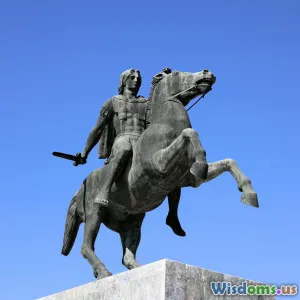
Comparing Inca and Aztec Marketplace Innovations
10 min read Explore innovative marketplace systems of the Inca and Aztec empires and their lasting impact on commerce and culture. (0 Reviews)
Comparing Inca and Aztec Marketplace Innovations
From the sprawling Andes to the arid Mexican highlands, two of the most remarkable pre-Columbian civilizations—the Inca and the Aztec empires—developed marketplace innovations that not only facilitated complex trade networks but also shaped societal structures and cultural practices.
In this detailed comparative exploration, we will unravel the marketplace innovations of these empires, highlighting their economic strategies, technological developments, and the broader social impacts of their commerce systems.
Introduction: The Pulse of Ancient Economy
Marketplaces in ancient civilizations were far more than spots of mere exchange; they embodied the lifeblood of these societies—spaces where economy, culture, politics, and social interactions intersected.
The Inca and Aztec empires, thriving in the 15th and 16th centuries, boasted vibrant marketplaces fostering extensive trade networks. Their approaches to marketplaces varied dramatically due to differing geographical, political, and cultural factors, offering unique insights into their societal complexity.
By comparing their marketplace innovations, we gain a richer understanding of how these great empires managed economic growth, social organization, and cultural identity through commerce.
Foundation of Marketplace Systems
Geographic and Economic Contexts
The Inca Empire, centered around the Andes mountains, thrived on a predominantly agrarian economy supported by advanced terracing, irrigation, and road systems. Their marketplaces served as hubs where regional specialization could meet the needs of a vast, yet administratively centralized empire.
Conversely, the Aztec Empire was based in the Basin of Mexico, surrounded by lakes and fertile lands that fostered lacustrine agriculture, including the famous chinampas (floating gardens). The Aztecs leveraged their strategic location and population density to create one of the most bustling marketplaces in the Americas.
Marketplace Centrality and Integration
Incan marketplaces were often tied closely to the state apparatus. The economy lacked a true currency system, relying instead on the mita labor tax and barter, with state redistribution playing a critical role. Their marketplace innovation was grounded in the integration of production, storage, and redistribution.
Aztec marketplaces, however, functioned as quasi-independent economic centers. Cities like Tlatelolco boasted marketplaces where thousands gathered daily, trading goods ranging from food to luxury items. Notably, Aztec marketplaces employed a form of currency—valued cacao beans and standardized cotton cloths called quachtli—enhancing transactional efficiency.
Key Innovations in Inca Marketplaces
State-Orchestrated Redistribution
A hallmark of Inca marketplace innovation was the role of the state in ensuring economic equilibrium. The centralized storehouses (qollqas) scattered along the Qhapaq Ñan road system preserved surpluses, which administrators redistributed during famines, religious festivals, or to support armies.
This unique integration of marketplace and state diminished the need for conventional market exchanges, allowing the Inca economy to prioritize collective welfare over individual profit.
The Qhapaq Ñan Road System
More than a transport route, the Qhapaq Ñan (Great Inca Road) was critical for the movement of goods and information. Stretching over 25,000 miles, it linked diverse ecological zones, facilitating the exchange of specialized goods such as coca leaves from the Amazon, fine textiles from the highlands, and marine products from coastal areas.
This expansive infrastructure underpinned the Inca’s marketplace efficiency, emphasizing logistical innovation over market autonomy.
Barter Economy and Absence of Coinage
Unlike many contemporaneous societies, the Incas did not use money. Marketplace exchanges operated primarily via barter, facilitated by units of labor and reciprocity systems like ayni (mutual aid) and mink'a (collective work). Such practices fostered social cohesion within marketplace contexts.
These innovations evidenced a highly communal approach to marketplace activities rather than individualistic commercial rivalry.
Aztec Marketplace Innovations
Scale and Complexity: The Tlatelolco Market
The Aztec marketplace of Tlatelolco, famously visited by Spanish conquistadors and chronicled by Bernal Díaz del Castillo, was one of the largest in pre-Columbian America. Estimates suggest it accommodated up to 60,000 visitors on peak days.
Market stalls displayed goods from all over Mesoamerica — from fiery chili peppers and maize to exotic luxury goods like jade and feathers.
Monetization and Currency System
The Aztecs innovated by introducing fungible currency forms such as cacao beans and quachtli cloth strips, each with a regulated value. This semi-monetary system facilitated barter by standardizing value, thus minimizing conversion disputes.
Such monetary innovations stimulated intricate trading practices, including credit, price setting, and supply chain management — sophisticated concepts for the period.
Market Regulation and Judicial Oversight
Aztec marketplaces were tightly regulated environments. Otomi market inspectors, known as pochteca, enforced rules to ensure fair trading, prevent fraud, and maintain order.
The pochteca also played dual roles as long-distance merchants and spies, highlighting how economic activities intertwined with political intelligence. Their existence signified specific administrative innovation blending market governance with empire security.
Specialized Guilds and Merchant Class
The Aztec economy also innovated through social structuring — merchant guilds managed specialized trade sectors. Pochteca merchants traveled vast distances to obtain luxury goods such as obsidian, textiles, and cacao.
Unlike the egalitarian Inca barter system, the Aztecs developed a rich merchant class that influenced politics and culture, exemplifying market social stratification.
Technological and Cultural Innovations Impacting Markets
Infrastructure: Marketplaces as Social Maxims
Incans developed marketplaces often adjacent to administrative and religious centers, imposing tight control and ensuring marketplace goods met state and ritual demands.
In contrast, Aztec marketplaces like Tlatelolco were public spaces—civic centers fostering social mingling and cultural exchange beyond economical purposes, with market days celebrated as important community events.
Communication and Record-Keeping
Incan commerce relied heavily on quipu—a complex system of knotted strings used for accounting and communication—to monitor goods, labor quotas, and redistributions.
The Aztecs, meanwhile, maintained pictographic codices and oral traditions to document trade and market practices, enabling historical continuity and effective administration.
Contemporary Lessons and Historical Impact
Sustainable Economic Models
The Inca’s state-centered, redistribution-based marketplace model emphasizes sustainability and social welfare, reminding modern economies of the value in balancing market freedom with social safety nets.
Market Scale and Regulation
The Aztec innovation combining complex market scale, currency, and regulation reveals the importance of institutional frameworks to sustain economic growth and consumer protection—concepts still significant in today’s market economies.
Cultural Endurance
Both marketplace systems facilitated vibrant cultural exchanges, reinforcing identity through trade practices retained in indigenous markets across South and Central America. For instance, community barter fairs and ceremonial marketplaces in the Andes today echo Inca traditions, while Mexican tianguis markets preserve Aztec roots.
Conclusion: Marketplace Innovations as Civilizational Cornerstones
While the Inca and Aztec marketplaces were shaped by unique environments and philosophies—the agrarian, redistributionist Inca and the commercial, regulated Aztec—they both mastered innovations that nurtured multifaceted economies.
Their marketplaces were not mere venues for trade but dynamic institutions harmonizing economic function with social values and political governance.
Studying their models invites reflection on diverse economic organization types, showing that marketplace success hinges not solely on trading goods but on integrating commerce with culture, technology, and community.
In embracing these lessons, contemporary global markets might find paths to more sustainable, inclusive, and culturally aware economic practices inspired by two of history’s greatest empires.
Rate the Post
User Reviews
Popular Posts




















